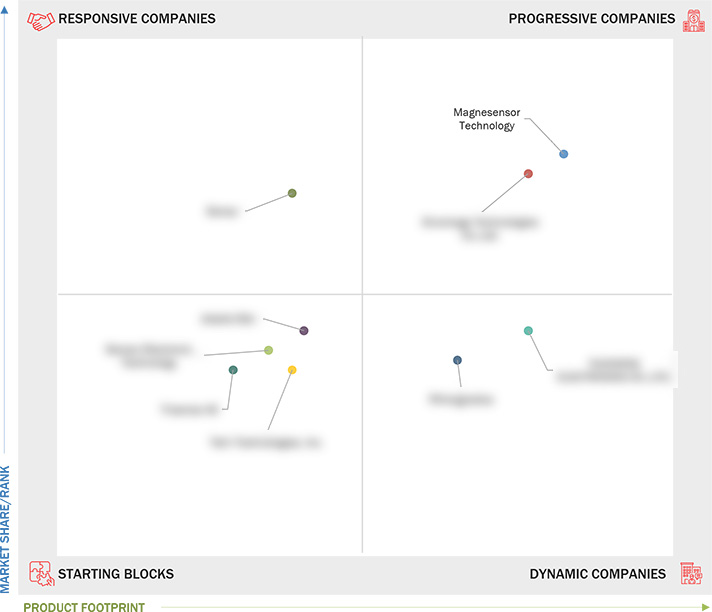Comparing 9 vendors in Current Sensor Startups across 0 criteria.
A current sensor detects electric current and converts it into an easily measurable output voltage that is proportional to the current flowing through a wire. Current measurement is vital in many power and instrumentation systems, where the current sensor monitors the electrical current and generates a corresponding signal. This signal can be in the form of analog voltage, current, or digital output. The generated signal is used to display the measured current on an ammeter or is stored for further analysis in a data acquisition system.
Market Leadership Quadrant
1.1 Study Objectives
1.2 Market Definition
1.3 Study Scope
1.3.1 Markets Covered and Regional Scope
1.3.2 Years Considered
1.3.3 Inclusions and Exclusions
1.4 Currency Considered
1.5 Unit Considered
1.6 Limitations
1.7 Stakeholders
1.8 Summary of Changes
2.1 Introduction
2.2 Market Dynamics
2.2.1 Drivers
2.2.1.1 Growing Use of battery-powered systems and increasing focus
on renewable energy
2.2.1.2 High adoption of Hall-effect current sensors
2.2.1.3 Increasing demand from consumer electronics industry
2.2.2 Restraints
2.2.2.1 Intense pricing pressure resulting in fluctuations in
average selling price
2.2.2.2 Accuracy and sensitivity trade-offs with high
electromagnetic interference
2.2.3 Opportunities
2.2.3.1 Increase in number of networked devices
2.2.3.2 Increase in manufacturing of hybrid and electric cars
2.2.3.3 Miniaturization of current sensors
2.2.3.4 Global investments for renewable energy adoptions
2.2.4 Challenges
2.2.4.1 Fluctuations in accuracy of current sensors over varying
temperature ranges
2.2.4.2 Need for product differentiation and development of
innovative solutions
2.3 Value Chain Analysis
2.4 Ecosystem Analysis
2.5 Investment and Funding Scenario
2.6 Trends/Disruptions Impacting Customer Business
2.7 Technology Analysis
2.7.1 Key Technologies
2.7.1.1 Microelectromechanical system (MEMS)-based current sensors
2.7.2 Adjacent Technologies
2.7.2.1 Microprocessor-based current sensors
2.7.2.2 Current relays
2.8 Impact of AI on Current Sensors Market
2.8.1 Introduction
2.9 Porter’s Five Forces Analysis
2.9.1 Intensity of Competitive Rivalry
2.9.2 Bargaining Power of Suppliers
2.9.3 Bargaining Power of Buyers
2.9.4 Threat of Substitutes
2.9.5 Threat of New Entrants
2.10 Key Stakeholders and Buying Criteria
2.11 Trade Analysis
2.11.1 Import Scenario (HS Code 850490)
2.11.2 Export Scenario (HS Code 850490)
3.1 Overview
3.2 Key Player Strategies/Right to Win, 2021–2025
3.3 Market Share Analysis, 2024
3.4 Revenue Analysis, 2020–2024
3.5 Company Valuation and Financial Metrics, 2024
3.6 Brand/Product Comparison
3.7 Company Evaluation Matrix: Startups/SMEs, 2024
3.7.1 Progressive Companies
3.7.2 Responsive Companies
3.7.3 Dynamic Companies
3.7.4 Starting Blocks
3.7.5 Competitive Benchmarking: Startups/SMEs, 2024
3.7.5.1 Detailed list of startups/SMEs
3.7.5.2 Competitive benchmarking of key startups/SMEs
3.8 Competitive Scenario
3.9 Product Launches
3.10 Deals
3.11 Expansions
3.12 Other Developments
4.1 SENSE
4.1.1 Business overview
4.1.2 Products/Solutions/Services offered
4.1.3 Recent developments
4.2 KWAN-TEK
4.2.1 Business overview
4.2.2 Products/Solutions/Services offered
4.2.3 Recent developments
4.3 MAGNESENSOR TECHNOLOGY
4.3.1 Business overview
4.3.2 Products/Solutions/Services offered
4.3.3 Recent developments
4.4 Sensor Electronic Technology
4.4.1 Business overview
4.4.2 Products/Solutions/Services offered
4.4.3 Recent developments
4.5 RVmagnetics
4.5.1 Business overview
4.5.2 Products/Solutions/Services offered
4.5.3 Recent developments
4.6 YUANXING ELECTRONICS CO., LTD.
4.6.1 Business overview
4.6.2 Products/Solutions/Services offered
4.6.3 Recent developments
4.7 Trisense ASSense
4.7.1 Business overview
4.7.2 Products/Solutions/Services offered
4.7.3 Recent developments
4.8 TELL-I TECHNOLOGIES, INC.
4.8.1 Business overview
4.8.2 Products/Solutions/Services offered
4.8.3 Recent developments
4.9 SINOMAGS ELECTRONIC TECHNOLOGY CO., LTD.
4.9.1 Business overview
4.9.2 Products/Solutions/Services offered
4.9.3 Recent developments



